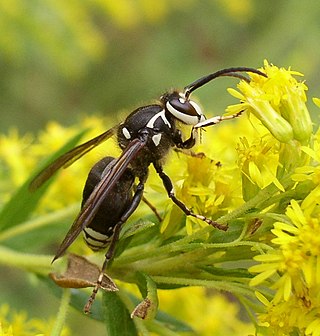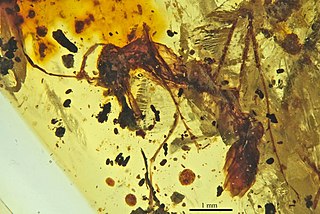
The Formicinae are a subfamily within the Formicidae containing ants of moderate evolutionary development.

Vespoidea is a superfamily of wasps in the order Hymenoptera. Vespoidea includes wasps with a large variety of lifestyles including eusocial, social, and solitary habits, predators, scavengers, parasitoids, and some herbivores.

Sphecomyrma is an extinct genus of ants which existed in the Cretaceous approximately 79 to 92 million years ago. The first specimens were collected in 1966, found embedded in amber which had been exposed in the cliffs of Cliffwood, New Jersey, by Edmund Frey and his wife. In 1967, zoologists E. O. Wilson, Frank Carpenter and William L. Brown, Jr. published a paper describing and naming Sphecomyrma freyi. They described an ant with a mosaic of features—a mix of characteristics from modern ants and aculeate wasps. It possessed a metapleural gland, a feature unique to ants. Furthermore, it was wingless and had a petiole which was ant-like in form. The mandibles were short and wasp-like with only two teeth, the gaster was constricted, and the middle and hind legs had double tibial spurs. The antennae were, in form, midway between the wasps and ants, having a short first segment but a long flexible funiculus. Three additional species, S. canadensis, S. mesaki and S. nexa, were described in 1985, 2005, and 2024, respectively.

Haidomyrmecinae, occasionally called hell ants, are an extinct subfamily of ants (Formicidae) known from Cretaceous fossils found in ambers of North America, Europe, and Asia, spanning the late Albian to Campanian, around 100 to 79 million years ago. The subfamily was first proposed in 2003 but had been subsequently treated as the tribe Haidomyrmecini and placed in the extinct ant subfamily Sphecomyrminae. Reevaluation of the Haidomyrmecini in 2020 led to the elevation of the group back to the subfamily. The family contains nine genera and 13 species.

Brownimecia is an extinct genus of ants, the only genus in the tribe Brownimeciini and subfamily Brownimeciinae of the Formicidae. Fossils of the identified species, Brownimecia clavata and Brownimecia inconspicua, are known from the Late Cretaceous of North America. The genus is one of several ants described from Late Cretaceous ambers of New Jersey. Brownimecia was initially placed in the subfamily Ponerinae, until it was transferred to its own subfamily in 2003; it can be distinguished from other ants due to its unusual sickle-like mandibles and other morphological features that makes this ant unique among the Formicidae. B. clavata is also small, measuring 3.43 millimetres (0.135 in), and a stinger is present in almost all of the specimens collected. The morphology of the mandibles suggest a high level of feeding specialization.

Zigrasimecia is an extinct genus of ants which existed in the Cretaceous period approximately 98 million years ago. The first specimens were collected from Burmese amber in Kachin State, 100 kilometres (62 mi) west of Myitkyina town in Myanmar. In 2013, palaeoentomologists Phillip Barden and David Grimaldi published a paper describing and naming Zigrasimecia tonsora. They described a dealate female with unusual features, notably the highly specialized mandibles. Other features include large ocelli, short scapes, 12 antennomeres, small eyes, and a clypeal margin that has a row of peg-like denticles. The genus Zigrasimecia was originally incertae sedis within Formicidae until a second species, Zigrasimecia ferox, was described in 2014, leading to its placement in the subfamily Sphecomyrminae. Later, it was considered to belong to the distinct subfamily Zigrasimeciinae.

Haidoterminus is an extinct genus of ant in the Formicidae subfamily Haidomyrmecinae, and is one of only nine genera placed in this subfamily. The genus contains a single described species Haidoterminus cippus and is known from one Late Cretaceous fossil which has been found in North America.

Haidomyrmex is an extinct genus of ants in the formicid subfamily Haidomyrmecinae, and is one of nine genera placed in the subfamily Haidomyrmecinae. The genus contains three described species Haidomyrmex cerberus, Haidomyrmex scimitarus, and Haidomyrmex zigrasi. All three are known from single Late Cretaceous fossils which have been found in Asia. H. cerberus is the type species and Haidomyrmex the type genus for the subfamily Haidomyrmecinae.

Burmomyrma is an extinct genus of aculeate hymenopteran, suggested to be an ant. The genus contains a single described species, Burmomyrma rossi. Burmomyrma is known from a single Middle Cretaceous fossil which was found in Asia.

Archimyrmex is an extinct genus of ant in the formicid subfamily Myrmeciinae, described by palaeoentomologist Theodore Cockerell in 1923. The genus contains four described species, Archimyrmex rostratus, Archimyrmex piatnitzkyi, Archimyrmex smekali and Archimyrmex wedmannae. Archimyrmex is known from a group of Middle Eocene fossils which were found in North America, South America, and Europe. The genus was initially placed in the subfamily Ponerinae, but it was later placed in Myrmeciinae; it is now believed to be the ancestor of the extant primitive genus Myrmecia from Australia. Despite this, Archimyrmex is not a member to any tribe and is regarded as incertae sedis within Myrmeciinae. However, some authors believe Archimyrmex should be assigned as incertae sedis within Formicidae. These ants can be characterised by their large mandibles and body length, ranging from 13.2 to 30 mm. They also have long, thin legs and an elongated mesosoma (thorax) and petiole.
Armaniinae is subfamily of extinct ant-like hymenopterans known from a series of Cretaceous fossils found in Asia and Africa. It is usually treated as one of the stem-group subfamilies in family Formicidae, although some myrmecologists treat it as a distinct family. A 2007 study analysing petiole and antenna morphology led to the proposal that at least some of the armaniid genera be placed in Sphecomyrminae, although others are unconvinced by the arguments and retain Armaniinae. The subfamily contains seven genera with fourteen described species.

Myanmyrma is an extinct genus of ants not placed into any Formicidae subfamily. Fossils of the single known species, Myanmyrma gracilis, are known from the Middle Cretaceous of Asia. The genus is one of several ants described from Middle Cretaceous ambers of Myanmar.

Gerontoformica is an extinct genus of stem-group ants. The genus contains thirteen described species known from Late Cretaceous fossils found in Asia and Europe. The species were described between 2004 and 2016, with a number of the species formerly being placed into the junior synonym genus Sphecomyrmodes.

Camelomecia is an extinct genus of stem-group ants not placed into any Formicidae subfamily and probably not into Formicidae itself. Fossils of the single known species, Camelomecia janovitzi, are known from the Middle Cretaceous of Asia. The genus is one of several ants described from Middle Cretaceous ambers of Myanmar.

Ceratomyrmex is an extinct genus of ant in the Formicidae subfamily Haidomyrmecinae. The genus contains a single described species Ceratomyrmex ellenbergeri and is known from several Late Cretaceous fossils which have been found in Asia.

Linguamyrmex is an extinct genus of ant in the formicid subfamily Haidomyrmecinae, and is one of only nine genera placed in the subfamily Haidomyrmecinae. The genus contains three described species, Linguamyrmex brevicornis, Linguamyrmex rhinocerus, and the type species Linguamyrmex vladi all known from Late Cretaceous fossils found in Asia.

Boltonimecia is an extinct genus of ant in the formicid subfamily Zigrasimeciinae. The genus contains a single described species, Boltonimecia canadensis, and is known from a single Late Cretaceous fossil which was found in Canada. The type species was originally described as a species of the extinct genus Sphecomyrma under the combination Sphecomyrma canadensis.

Zigrasimeciinae is a subfamily of ants, known from the Cretaceous period, originally named as the tribe Zigrasimeciini within the subfamily Sphecomyrminae by Borysenko, 2017, it was elevated to full subfamily in 2020. It contains three described genera. They are sometimes known as iron-maiden ants in reference to their densely spiked mouthparts, reminiscent of an iron maiden torture device, that were likely used to trap prey. Boltonimecia canadensis was described from Campanian Canadian amber out of Alberta, Canada, while the species of Protozigrasimecia and Zigrasimecia are both exclusively known from Cenomanian Burmese amber found in Myanmar.
















